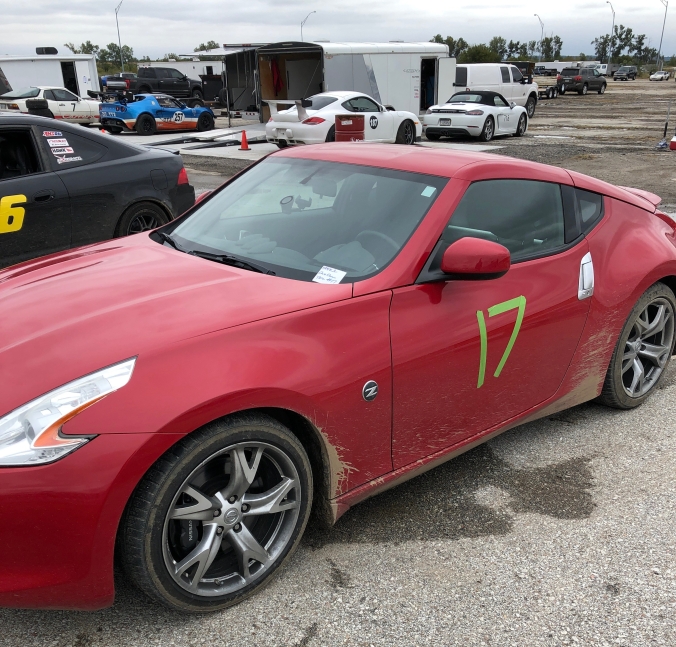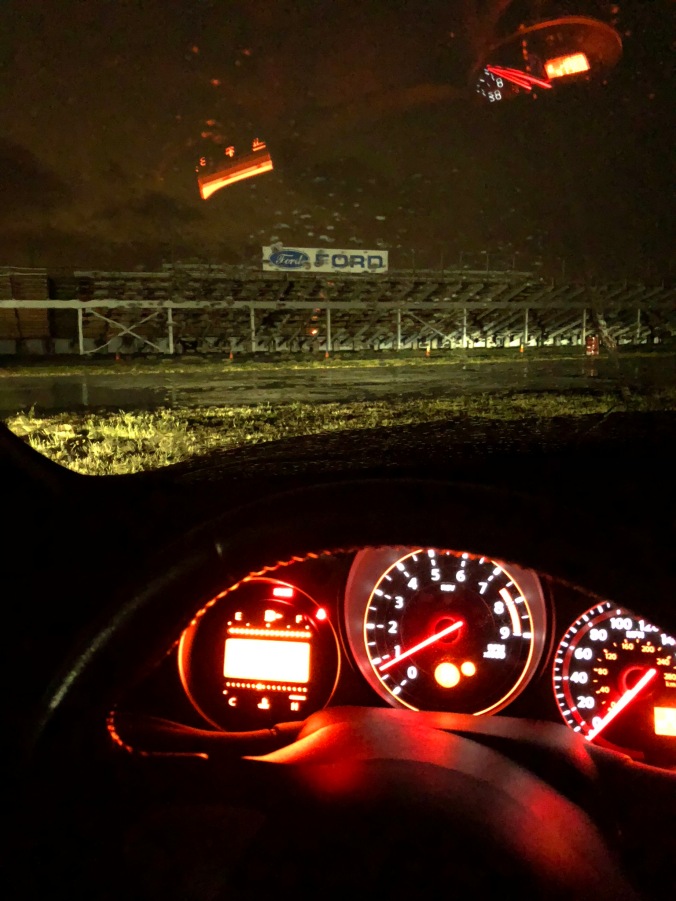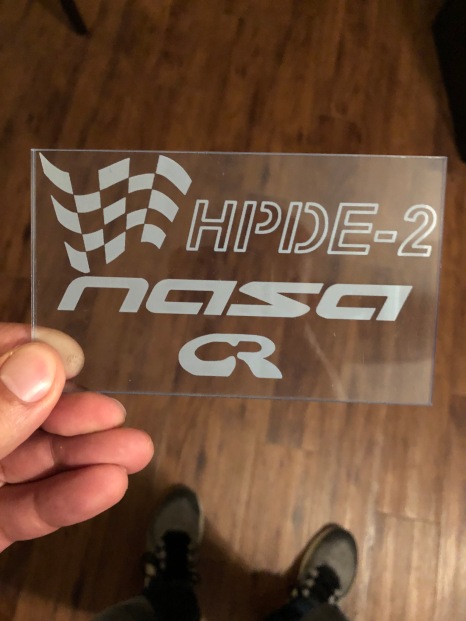
My 2010 370Z with handcrafted numbering and mud from turn 3.
Over the course of this past summer, I found myself diving back into the gearhead world. It started with the simple things, talking to guys I knew were into wrenching, going to the occasional car show. But by the end of August, I was running out on the streets late at night. I’d take my 2010 Nissan 370Z Sport out for a spin to find any place that was open and unpopulated enough to rev up the glorious VQ37VHR to redline. I’d dig through Google maps during the day to find those glorious spaghetti roads that make you feel alive as you take the turns.
Somewhere along the line, I realized I was holding back the car from it’s performance potential. The new Z is a modern marvel. I know, I know…it’s not the GT-R (shoulda kept the ‘Skyline’ moniker, Nissan. Tsk, tsk), but with 332 crank horsepower, a smooth 6-speed manual gearbox with rev-matching, big and meaty tires, and fantastic suspension tuning, this car is meant to put down solid lap times at your local road course.
Note: I said road course, not streets.
The lightbulb went on, and I started looking up all the fun ways to get on a track.
NASA
I’ve always loved the National Aeronautics and Space Administration, but I’m not talking about that variant of the acronym today. The National Auto Sport Association is one of the two major entry-level motorsport clubs, the other being the Sports Car Club of America (SCCA). While both of these clubs have driver’s education and plenty of time spent on track, I found that NASA’s level-up High Performance Driver’s Education (HPDE) aligned well with what I wanted to do. HPDE is broken down into four groups:
HPDE-1: You hit the track in your car and drive around with an instructor in the right seat. They give you pointers or yell at you, depending on what’s required in the moment. After each session, which is normally about 20 minutes, there is a “download/debrief,” where you meet with the rest of the drivers and a senior instructor, and discuss the session. You can ask questions, get tips, and lodge complaints against other drivers if necessary. On track, there is no passing unless the driver in front points you by.
HPDE-2: You are deemed by your instructor as safe enough to be on the track without him in the passenger seat. Passing rules are the same as HPDE-1, as you run with them, and you join the HPDE-1 drivers in the post-drive download session. To move up to HPDE-3, you must have a checkride with an instructor.
HPDE-3: Passing rules are looser here, and the speeds are starting to move up.
HPDE-4: Passing is open, and we’re starting to hit race speeds in the cars.
There is no limitation on how long you have to stay in each group. It is up to you and your instructors to determine where you fit best. However, as you progress, you will receive sign-offs in your “NASA Passport” which allows you to run in your proper group at any national NASA event, no matter what region or track you go to. After you finish HPDE you can start running in time trials or you can get your competition license to race wheel-to-wheel, if you so choose.
This all sounded perfect to me, so I hopped back on the interwebs and found the soonest and nearest event. It would be early October at Racing Park of the Midlands (RPM) in Iowa.
Getting Prepared (insert montage here)
I had figured that getting prepared for my first HPDE would largely be a mental exercise. After all, it is touted that you can just show up to HPDE-1 in your street car and be fine (which I did see by way of a Toyota Camry).
However, after a little research, I’d soon find that I wouldn’t be so lucky. The early model year 370Z’s have a few minor issues that need to be addressed before they are track-ready. First off, I have a Sport model. While that has some cool upgrades such as the aforementioned rev-matching SynchroRev transmission, front/rear spoilers, better wheels, and the Akebono brake package, the pads that are used in the brakes are awful for track use. Some reports I saw mentioned that a standard set of street pads would be to the backing plates (a.k.a., toast) after one day of tracking. That would be my first order of business: I placed an order for Carbotech XP10f/XP8r pads, which came highly recommended by the gang at the370z.com. A secondary but related problem was that the fluid used in the brakes and clutch would boil with heavy track use. The solution was to upgrade to Motul RBF 600 fluid for both, which has a much higher boiling point.
Finally, my 2010 Z has no oil cooler. This means that it will overheat the oil in a few laps, cutting my sessions short. That simply would not do. The later model years have built a small oil cooler into the radiator as a nod from Nissan that this was indeed an issue. However, even that cooler is not substantial enough for heavy track use. I placed an order for a Fast Intentions 34-row oil cooler, which would handle anything I could ever imagine to throw at the Z.
Parts and fluids now ordered, I had some time to wait for everything to arrive. I spent my workday mornings watching videos of RPM to learn the visual cues of the track. I located a few videos on Youtube which had cars of similar power to mine, so I could get a feel for the speeds at which I’d be encountering each turn. I’d quiz myself about each turn’s approximate angle (90 degree or 45 degree turn?), where the apexes were (where to touch the inside corner), where the track outs were located (the end of the turn), and what preceded/followed each turn. It was good fun to get a feel for the track even before being there once.
The Motul fluid was the first to arrive, so the weekend before the HPDE I swapped out the brake/clutch fluid and bled the brakes. This was actually my first time doing any real work to the Z, even after owning it for over a year. I was amused by that, as I’ve never gone that long without modifying a car. The Carbotechs would arrive two days later, on Tuesday. That night, I worked feverishly to get them in the car, hoping to finish before the sun set. I bolted the wheels back on around 10PM, killing that hope, though it did work out. The Carbotechs are a heavy metal brake set that require something called “bedding.” After I finished the install, I found a long and empty road nearby so I could perform this process, which involved a sequence of heavy braking from 60-20mph and 80-30mph. Everything worked great and the car felt like it would stop on a dime after this upgrade.
The oil cooler didn’t arrive until Thursday night and it was pouring rain all day. That meant I’d have to install it Friday afternoon and immediately leave for Iowa when I was finished. That also meant wringing out the car would be done on the 2.5 hour drive to the hotel in Bellevue, NE.
I managed to get the oil cooler installed in about 3 hours, damned good time. I actually had just enough time to unwind, shower, eat, and load up the car before rush hour in my area.
The drive up was pretty uneventful. Lots of empty highway and very few cars were on the road after I passed St. Joe’s. I stopped after the first hour to check my oil level and make sure the cooler wasn’t leaking anywhere. Everything looked great, so I carried on.
Speaking of the cooler, it was outstanding! Normal highway driving puts my 370Z in the 220 degree range. With the cooler on, it sat around 180 degrees and eventually dropped down to 160 as the ambient temperature started to dip into the 40s.
The Track
The morning of the first day was wet and dark. I arrived at RPM before everyone, so I had to guess at were to pull in and wait. Eventually, cars and people started to arrive, and the sun started to poke its head above the horizon. I met a few of the guys that would be running with me in HPDE-1/2, as well as my instructors for the day. My in-car instructor would be a fellow named Kurt, who drove a stripped-out time trials S2000. I would ride with Kurt the next day…Kurt was damned fast. The group instructor was an older guy named Terry, who was effing hilarious, and incredibly knowledgeable.

The First Morning. It’s 7AM.
We spent about an hour in the driver’s meeting, where they gave us some general racing line advice as well as detailing track etiquette. We also learned about the flags that could be waved in several of the manned corners of the track to inform the drivers during the sessions. For example:
- Blue w/yellow stripe: Let the guy behind you pass
- Yellow: Caution, slow down
- Red: Session over, stop
- Black w/red circle (meatball): Your car is broken, come in.
- Checkered: Last lap
And I was off! Kurt and I donned our helmets and headed for the grid. It was still cold at this point, but at least it had stopped raining. We expected a little slickness and some puddles. There was a first lap to get tires and brakes up to temp, and then we were driving!
I would spin twice, but none of them were terrible. The first was an on track spin at slick turn 9, where there were a ton of offs. The second was after a trip through the mud of turn 3 (see the first pic). The first was because of the slick conditions, but the second was because I was starting to push the car harder than I had ever pushed a car. I had to get used to concepts that you don’t deal with in every day driving. I’ll discuss these more at some point in the future. By the end of the day, the track was dry and we were really starting to get moving. I was exceeding 120MPH on the front straight and beginning to brake hard coming into the turns. I started to grapple with the ABS pulsating and the tires running out of grip. I was having a blast.
And in a flash, Day One was over.
Day Two
I’ll get this out of the way now: the second day was miserable. After the first session, it started to pour and it never let up. With temperatures in the 40’s, it was a slick, puddley mess on the track all day.
Kurt and I didn’t let that stop us. We hopped back in the Z and got to work. The racing lines are a lot different in the wet. Places where you used to drive because they had lots of grip were now slick. I had to change everything and learn new turn-in points and braking zones. I had to dodge puddles growing larger throughout the day. The rear end stepped out more often, but along the way I simply figured out “countersteer and modulate throttle.” It was rough, and I was anxious all the way through.
After the second session, I asked Kurt about moving up to HPDE-2. I told him I like him plenty but he was weighing down my car. We found out that he could give me a checkride on the next session. We went out, everything went swimmingly, and he gave me a thumbs up. That meant I’d get to drive solo for the last session, which was awesome! And I even got a lil’ plaque to commemorate the event:

They don’t just give these to anybody, ya know?
Since almost everyone had left by this point, there were only 5 cars that would be on the track for the final session, and they’d be grouping all the cars together for a 40-minute free-for-all. My first time out and I had to survive double my normal session! As a nice bonus, I downloaded Harry’s Lap Timer onto my phone so I could record lap times, video, and other data while driving around.
The session went off reasonably well. I was starting to get much more comfortable smashing the brakes in the awful wet, and my lap times dropped in response. And then, about halfway in, I simply forgot to brake on turn 5 until it was too late. I drove right off into the grass. I came into the pit for a quick inspection, and they sent me immediately back out. A complete brain fart and I survived unscathed. I kept pushing for the rest of the session, and before I knew it, 40 minutes had passed and the weekend was over. Here’s some video from the fastest lap in that 40 minute session:
Some Thoughts
First off, I’m not going to say that I recommend this for anyone. There’s a certainly level of comfort that you’re going to need with a few things:
- Going way faster than you’ve ever gone on the street (legally).
- Completely changing how you apply brake and throttle. It’s almost the inverse of the street.
- Getting passed by people driving much faster than you.
- Sometimes completely losing control and going along for the ride until it stops.
Not everyone can handle all of these things. And obviously, if your car isn’t up to the task you shouldn’t go, though tech inspection should catch that.
But if you do find yourself itching to try it out, go for it! I found that absolutely everyone was friendly and willing to trade tips, even the racing drivers. And of course, everyone is making sure that the whole event is run safely. There are very few accidents at NASA HPDE’s, and most times the ones that do happen are fairly tame.
I’ve had about a week since the event to reflect. If you’ve read some of my previous posts, you’ll know that I’ve been a gearhead since about 2001. I enjoy turning wrenches and bolting newfangled parts on. I’ve always loved “go faster” bits like turbos, coilovers, and exhausts, but rarely have I done anything that really tested those modifications.
The track is one of those ultimate litmus tests, much like a dyno for engine horsepower. It tests the sum total of the car and the driver. It seeks the weakest points and exposes them. It is the driver’s job to identify these deficiencies and rectify them.
Over the course of the weekend, obviously, I was the weakest link in the chain. I have very little high speed experience, and I did fail to perform quite a few times. However, even on the first day, I could start to sense some things that I’ll need to improve. First, I need some better tires for track days. There were two turns (5/6 & 14) where the stock street tires (Pilot A/S3+) completely ran out of grip and began squealin’ like little piggies. They’ll need to be upgraded to Nitto or Toyo racing tires. Second, I definitely need some kind of exhaust improvement. Besides simply wanting one for the sound, I had some real issues where I couldn’t tell that I was in the wrong gear simply from hearing the revs. The wind noise was louder than the stock exhaust. In the video you can barely hear the engine, and it was even duller in my helmet. Of course, most of the immediate improvement moving forward is going to come from seat time and focused learning.
Finally, I want to make a note about the more visceral side of the experience. There is nothing quite like doing road course work, especially as a newbie. I started out anxious and worried, and gradually progressed into being comfortable and competent (twice!). I found that transition to be very rewarding, especially once I was left out on my own. I didn’t notice this in the moment, but just after: the experience heightens your focus of your senses. Not only was I mentally focused on my different points to get around the track, but my eyes are looking everywhere for problems (other cars, puddles), my ears are listening for something unsettling (squeal of rubber or broken banging), and my whole body is trying to feel how the car is sliding around the track. Is the rear loose? Is the steering wheel fighting me? Is the engine pulling hard? Do the brakes feel right? And this is constant. It’s exhilarating to be so connected and so hyper-aware of the world. When you couple that with the drive to do well, it’s a complete package for absolute bliss.
I can’t wait to do it again. I hope to see you out there!